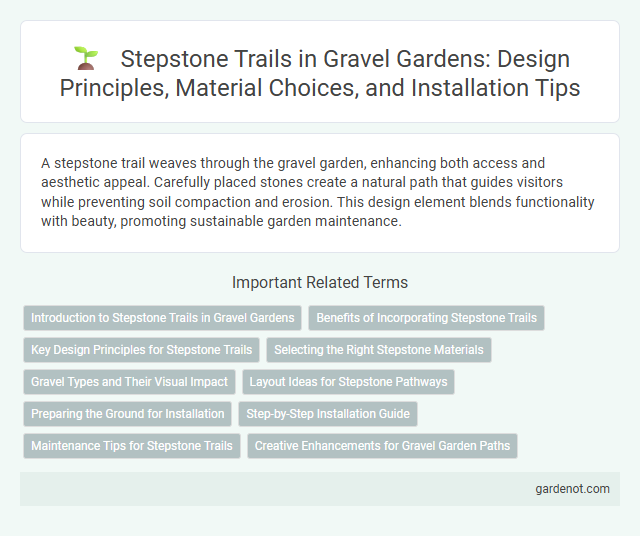A stepstone trail weaves through the gravel garden, enhancing both access and aesthetic appeal. Carefully placed stones create a natural path that guides visitors while preventing soil compaction and erosion. This design element blends functionality with beauty, promoting sustainable garden maintenance.
Introduction to Stepstone Trails in Gravel Gardens
Stepstone trails in gravel gardens create defined pathways that enhance landscape accessibility while promoting natural drainage. These trails combine flat, stable stones with surrounding gravel, ensuring durability and low maintenance. Incorporating native plants alongside stepstone trails supports biodiversity and adds visual interest to gravel garden designs.
Benefits of Incorporating Stepstone Trails
Stepstone trails enhance gravel gardens by improving accessibility and preventing soil erosion, allowing gardeners and visitors to navigate uneven terrain with ease. These trails promote better water drainage, reducing runoff and maintaining soil stability around delicate plant roots. Integrating stepstones also adds aesthetic value, creating natural focal points that blend seamlessly with the garden's organic texture.
Key Design Principles for Stepstone Trails
Stepstone trails in gravel gardens emphasize durability, slip resistance, and natural integration by using robust materials such as flagstone or concrete pavers set firmly into compacted gravel or soil. Strategic spacing ensures stability underfoot and allows for natural drainage, reducing erosion and maintaining trail integrity. Incorporating native vegetation alongside stepstones enhances aesthetic cohesion and promotes ecosystem health within the gravel garden environment.
Selecting the Right Stepstone Materials
Choosing durable materials like bluestone, flagstone, or slate ensures long-lasting stepstones in a gravel garden. These stones provide natural slip resistance and complement the garden's aesthetic while withstanding weather conditions. Proper thickness and surface texture enhance safety and stability, creating an inviting and functional stepstone trail.
Gravel Types and Their Visual Impact
Stepstone trails in gravel gardens utilize a variety of gravel types such as crushed granite, pea gravel, and river rock, each offering unique textures and colors that enhance visual interest. Crushed granite provides a coarse, angular look that contrasts beautifully with smooth, rounded pea gravel, while river rock introduces natural earth tones and polished surfaces. The strategic selection and combination of these gravel types define the trail's aesthetic, guiding visitors visually through the garden space.
Layout Ideas for Stepstone Pathways
Stepstone pathways in gravel gardens create dynamic visual interest and guide foot traffic seamlessly through natural landscapes. Arranging stepstones in staggered or irregular patterns encourages organic movement while maintaining stability and easing maintenance. Incorporating diverse shapes and sizes enhances texture contrast against the gravel, promoting both functionality and aesthetic appeal in garden design.
Preparing the Ground for Installation
Preparing the ground for installing a stepstone trail in a gravel garden involves clearing the area of debris and leveling the soil to ensure stability and proper drainage. Compacting the soil and adding a layer of sand or fine gravel creates a solid base that prevents stones from shifting over time. Precise measurements and layout planning help position the stepstones evenly, enhancing both functionality and aesthetic appeal.
Step-by-Step Installation Guide
Create a durable stepstone trail in your gravel garden by first laying out the design and marking the placement of each stone for consistent spacing. Excavate shallow holes slightly larger than each stepstone, ensuring a level base by adding and compacting a layer of sand or gravel beneath. Place the stepstones firmly, checking for stability and alignment, then fill gaps with fine gravel or soil to secure them and promote natural drainage.
Maintenance Tips for Stepstone Trails
Maintaining stepstone trails in gravel gardens requires regular cleaning to prevent moss and algae buildup, which can make stones slippery and hazardous. Periodically check for loose or uneven stones, resetting them with gravel or sand to ensure stability and safe footing. Installing proper drainage nearby prevents water accumulation, reducing erosion and prolonging the trail's durability.
Creative Enhancements for Gravel Garden Paths
Incorporating creative enhancements such as mosaic patterns, embedded glass gems, and natural stone variations elevates the aesthetic appeal of gravel garden stepstone trails. Strategic placement of lighting along the path not only improves safety but also adds ambiance, highlighting textures and colors in low light. Integrating native plants and succulents between stones ensures a seamless blend with the natural environment, promoting sustainability and visual interest.
Stepstone trail Infographic

 gardenot.com
gardenot.com